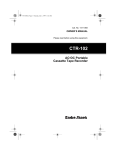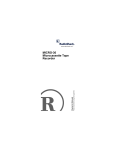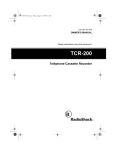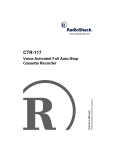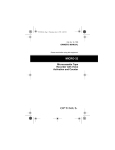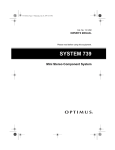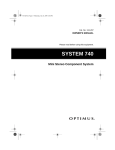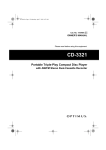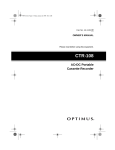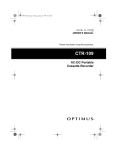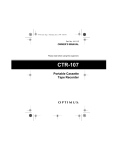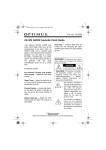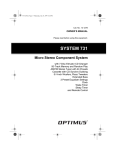Download Radio Shack Portable Cassette Recorder Owner`s manual
Transcript
14-1107.fm Page 1 Thursday, July 1, 1999 11:15 AM Cat. No. 14-1107A OWNER’S MANUAL Please read before using this equipment. CTR-94 DC Portable Cassette Tape Recorder 14-1107.fm Page 2 Thursday, July 1, 1999 11:15 AM FEATURES Your Radio Shack CTR-94 DC Portable Cassette Tape Recorder is reliable, easy-to-use, and very handy at home, in your office, in your vehicle, or anywhere you go. Its features include: Automatic Stop — protects the tape and tape handling parts by automatically stopping the tape when it reaches the end. Automatic Level Control (ALC) Circuit — ensures quality recording by automatically setting the proper recording level. Record/Battery Indicator — flikers during recording and lights steadily when the batteries need replacing. Built-in Condenser Microphone — gives you high-sensitivity for recording conferences or lectures. Supplied Earphone — let you listen in privacy. Auxiliary Input Jack — lets you connect a radio, tape deck, or CD player so you can record from these external audio sources. External Microphone Jack — lets you connect an external microphone so you can record an individual but exclude the surrounding noise Remote Control Jack — lets you connect an external microphone with an on/off switch so you can control the CTR-94 from your microphone. Erasing Plug — plugs into the external microphone jack so you can erase a cassette tape by recording silence. Retractable Handle — lets you easily carry the CTR-94. Three Power Sources — let you power the CTR-94 from four C batteries (not supplied), standard AC power (with an optional AC adapter), or vehicle DC power (with an optional DC adapter). © 1996 Tandy Corporation. All Rights Reserved. Radio Shack is a registered trademark used by Tandy Corporation. 2 14-1107.fm Page 3 Thursday, July 1, 1999 11:15 AM CONTENTS Preparation ....................................................................................................... 4 Connecting Power ....................................................................................... 4 Using Internal Batteries ......................................................................... 4 Checking the Battery Condition............................................................. 5 Using AC Power .................................................................................... 5 Using Vehicle Battery Power ................................................................. 6 Connecting an Earphone ............................................................................. 7 Listening Safely ..................................................................................... 7 Traffic Safety ......................................................................................... 7 Operation .......................................................................................................... 8 Loading a Cassette ...................................................................................... 8 Playing a Tape ............................................................................................. 8 Recording .................................................................................................... 9 Using the Built-In Microphone ............................................................... 9 Using an External Microphone .............................................................. 9 Recording from an External Audio Source .......................................... 10 Tape Tips ................................................................................................... 11 Recommended Tapes ......................................................................... 11 Erasing a Cassette Tape ..................................................................... 11 Preventing Accidental Erasure ............................................................ 12 Restoring Tape Tension and Sound Quality ........................................ 12 Maintenance.................................................................................................... 13 Cleaning the Tape-Handling Parts ............................................................. 14 Specifications ................................................................................................. 15 3 14-1107.fm Page 4 Thursday, July 1, 1999 11:15 AM PREPARATION CONNECTING POWER You can power your CTR-94 from any of these power sources: • Internal batteries • Standard AC power (with an optional AC adapter) • Vehicle battery power (with an optional DC auto adapter) Note: Connecting an adapter disconnects the internal batteries. Using Internal Batteries You can power your CTR-94 from four C batteries (not supplied). For the best performance, we recommend alkaline batteries, such as Cat. No. 23-551. 1. Press down on the battery compartment cover’s grooves and slide it off in the direction of the arrow. Cautions: • Always dispose of old batteries promptly and properly. • Never leave dead, old, or weak batteries in the CTR-94. Batteries can leak chemicals and corrode or damage electronic circuits. • If you do not plan to use batteries in the CTR-94 for a month or more, remove the batteries to protect the CTR94 from possible battery leakage. 3. Install the batteries as indicated by the polarity symbols (+ and –) marked inside the battery compartment. Cautions: • Use only fresh batteries of the required size and type. • Never mix fresh and old batteries, or different battery types. 4. Replace the cover. 2. Remove the old batteries (if necessary). 4 14-1107.fm Page 5 Thursday, July 1, 1999 11:15 AM Checking the Battery Condition To check the battery’s condition, press PLAY, REWIND , or FAST-F. If the RECORD/BATTERY indicator lights steadily, the batteries need replacing. (illus) • Always plug the adapter into the CTR-94 before you plug it into the AC outlet, and always unplug the adapter from the AC outlet before you unplug it from the CTR-94. Note: The recorder automatically disconnects internal batteries when you connect an AC adapter. 1. Set the adapter’s voltage switch to 6V. (illus) Using AC Power You can also power the CTR-94 from standard AC power using an AC adapter, such as Radio Shack Cat. No. 273-1662 (not supplied). 2. Insert the adapter’s green-tipped barrel plug into the adapter’s cord so it reads TIP-NEG. (illus) Cautions: • The recommended adapter supplies 6 volts and delivers at least 300 milliamps. Its center tip is set to negative, and its plug correctly fits the CTR-94’s DC 6V jack. Using an adapter that does not meet these specifications could seriously damage the CTR-94 or the adapter. 3. Plug the adapter’s barrel plug into the DC 6V jack on the left side of the CTR-94. EAR DC 6V + AUX REM MIC MIN – VOLUME – MAX - 4. Plug the other end of the adapter into a standard AC outlet. 5 14-1107.fm Page 6 Thursday, July 1, 1999 11:15 AM Using Vehicle Battery Power You can also power the CTR-94 from your vehicle’s battery using an auto DC adapter (such as Radio Shack Cat. No. 14-844, not supplied) that connects to your vehicle’s cigarettelighter socket. Cautions: • The recommended DC adapter supplies 6 volts and delivers at least 300 milliamps. Its center tip is set to negative, and its plug correctly fits the recorder’s DC 6V jack. Using an adapter that does not meet these specifications could seriously damage the recorder or the adapter. 2. Insert the DC adapter’s blacktipped barrel plug into the adapter’s cord so it reads TIPNEG. (illus) 3. Insert the adapter’s barrel plug into the CTR-94’s DC 6V jack. EAR DC 6V + AUX REM MIC MIN – VOLUME – MAX - • Always plug the adapter into the recorder before you plug it into the cigarette-lighter socket, and always unplug the adapter from the cigarette-lighter socket before you unplug it from the recorder. 1. Set the DC adapter’s voltage switch to 6V. (illus) 6 4. Plug the adapter’s larger plug into the vehicle’s cigarette lighter socket. 14-1107.fm Page 7 Thursday, July 1, 1999 11:15 AM CONNECTING AN EARPHONE For private listening, you can use the supplied earphone. Insert the earphone’s 1/8-inch plug into the EAR jack. EAR AUX REM MIC MIN – VOLUME – MAX Note: Connecting the earphone automatically disconnects the built-in speaker. Listening Safely To protect your hearing, follow these guidelines when you use an earphone. • Do not listen at extremely high volume levels. Extended high volume listening can lead to permanent hearing loss. • Set the volume to the lowest setting before you begin listening. After you begin listening, adjust the volume to a comfortable level. • Once you set the volume, do not increase it. Over time, your ears adapt to the volume level, so a volume level that does not cause discomfort might still damage your hearing. Traffic Safety Do not wear an earphone while operating a motor vehicle or riding a bicycle. This can create a traffic hazard and is illegal in some areas. Even though some earphones are designed to let you hear some outside sounds when listening at normal volume levels, they still present a traffic hazard. 7 14-1107.fm Page 8 Thursday, July 1, 1999 11:15 AM OPERATION LOADING A CASSETTE 1. Take up any slack in the tape by turning one of the cassette’s hubs with a pencil. PLAYING A TAPE Warning: To protect your hearing, set VOLUME to its lowest setting before you begin playing a cassette tape. EAR (illus) Caution: If you do not remove excess slack, the tape might get tangled in the record/playback mechanism. 2. Press STOP/EJECT to open the cassette compartment door. AUX REM MIC MIN – VOLUME – MAX 1. Load a prerecorded cassette tape into the compartment. 2. Press PLAY. The cassette plays until it reaches the end of the side, then it automatically stops and PLAY releases. MIC CT R- 94 AC /BA TT ERY CA SS ET TE R EC ORD ER MIC CT R- 94 AC /BA TT ERY CA SS ET TE R EC ORD ER RECORD PLAY REWIND FAST-F STOP EJECT RECORD PLAY REWIND FAST-F STOP EJECT PAUSE PAUSE Notes: 3. Load the cassette with its open edge toward the controls, the desired side facing up, and its full reel on the left. (illus) 4. Close the door. 8 • Press PAUSE to temporarily stop playback. To resume playback, press PAUSE again. • Press FAST-F or REWIND to rapidly wind the tape forward or backward. To resume play, press STOP/EJECT then PLAY. • The cassette automatically stops when the tape reaches the end only in the PLAY or RECORD modes, and not in the FAST-F or REWIND modes. 14-1107.fm Page 9 Thursday, July 1, 1999 11:15 AM 3. Adjust VOLUME to the desired listening level. 4. Press STOP/EJECT to completely stop playback before it automatically stops. Press STOP/EJECT again to open the cassette compartment and remove the cassette. RECORDING 3. Press RECORD to begin recording. Both PLAY and RECORD lock down. CT R- 9 4 A C/B AT TE RY C AS SET TE RE COR DER MIC RECORD PLAY REWIND FAST-F STOP EJECT PAUSE 4. Speak into MIC. MIC Notes: CT R- 9 4 A C/B AT TE RY C AS SET TE RE COR DER RECORD • Before you load a cassette tape for recording, be sure the cassette’s erase-protection tabs are in place (see “Preventing Accidental Erasure”). • The CTR-94’s Automatic Level Control (ALC) circuit automatically adjusts the recording level. VOLUME has no effect on recording. Using the Built-In Microphone The built-in condenser microphone is a high-sensitivity microphone that easily picks up sounds, near or far. This is handy for recording conferences or lectures. 1. Load a blank cassette tape, or one you want to record over, into the cassette compartment. 2. Place the recorder 2 or 3 feet from the recording source. PLAY REWIND FAST-F STOP EJECT PAUSE Note: To temporarily stop recording, press PAUSE. To resume recording, press PAUSE again. 5. Press STOP/EJECT recording. to stop Using an External Microphone You can connect an external microphone with a 1/8-inch plug to the recorder. This is handy for when you want to record only an individual’s voice and exclude all other sounds in the surrounding area. Your local Radio Shack store carries a wide variety of external microphones. Note: Connecting an external microphone automatically disconnects the built-in condenser microphone. 9 14-1107.fm Page 10 Thursday, July 1, 1999 11:15 AM 1. Load a blank cassette tape, or one you want to record over, into the cassette compartment. Recording from an External Audio Source 2. If the external microphone has only a 1/8-inch plug, insert it into the recorder’s MIC jack. You can record directly from an external audio source, such as a radio, tape deck, or CD player, using a suitable patch cord (not supplied) with a 1 /8-inch plug. EAR AUX REM MIC Note: Before you connect an external audio source to the recorder, be sure the source’s and the recorder’s volume controls are set to their minimum setting. MIN – VOLUME – MAX 1. Load a blank cassette tape, or one you want to record over, into the cassette compartment. If the external microphone has two plugs and an on/off switch, you can remotely control the CTR-94 from your microphone. Insert the microphone’s 1/8-inch plug into the recorder’s MIC jack, and the smaller plug into the REM jack. 3. Press RECORD to begin recording. Both PLAY and RECORD lock down. Note: To temporarily stop recording, press PAUSE on the recorder (or OFF on the microphone). To resume recording, press PAUSE again on the recorder (or ON on the microphone). 4. Speak into the external microphone. 5. Press STOP/EJECT recording. 10 to stop 2. If you connected an external microphone, disconnect it. 3. Connect your external audio source to the AUX jack, using an optional patch cord with a 1/8inch plug at one end and the appropriate plug at the other end that matches your audio source’s output jack. EAR AUX REM MIC MIN – VOLUME – MAX 4. Start the sound source and set its volume to a normal listening level. 14-1107.fm Page 11 Thursday, July 1, 1999 11:15 AM Note: During recording, the speaker is muted. If you want to monitor the recording, use the supplied earphone. 5. Press RECORD to begin recording. Both PLAY and RECORD lock down. Note: To temporarily stop recording, press PAUSE . To resume recording, press PAUSE again. 6. Press STOP/EJECT recording. to TAPE TIPS Recommended Tapes Tape quality greatly affects the quality of the recording. We recommend extended-range or low noise Type 1 regular length (60- or 90-minute) normal-bias cassette tapes. We do not recommend long-play cassette tapes such as C-120s because they are thin and easily tangle. stop Important: Most material on prerecorded tapes is copyrighted. Unauthorized duplication of copyrighted material is a violation of the copyright laws of most countries and such duplication may result in fines and/or imprisonment. Note, however, that in the United States, it is not a violation of U.S. copyright laws for a consumer to use an audio recording device to duplicate musical recordings for noncommercial (personal) use. Erasing a Cassette Tape To record over a cassette tape, simply record as usual. The cassette deck records over the previous recording. To erase a cassette tape, insert the supplied erasing plug into the MIC jack and press RECORD. EAR AUX REM MIC MIN – VOLUME – MAX Note: Be sure you have not connected anything to the AUX jack. If you need to erase an entire cassette, you might prefer using a bulk tape eraser, which is available at your local Radio Shack store. 11 14-1107.fm Page 12 Thursday, July 1, 1999 11:15 AM Preventing Accidental Erasure Cassette tapes have two erase-protection tabs — one for each side. When a tab is in place, you can record on that side. To protect a recording from being accidentally recorded over or erased, use a screwdriver to remove one or both of the cassette tape’s eraseprotection tabs. This prevents RECORD from being pressed. (illus) If you later decide to record on a tape side after you have removed the erase-protection tab for that side, place a piece of strong plastic tape over that side’s erase-protection hole. Be sure you cover only the hole originally covered by the erase-protection tab. (illus) 12 Caution: Removing the erase-protection tabs does not prevent a bulk eraser from erasing a cassette tape. Restoring Tape Tension and Sound Quality After you play a cassette tape several times, the tape might become tightly wound on the reels. This can cause playback sound quality to deteriorate. To restore the sound quality, fast-forward the tape from the beginning to the end of one side, then completely rewind it. Then loosen the tape reels by gently tapping each side of the cassette’s outer shell on a flat surface. Caution: Be careful not to damage the cassette when tapping it. Do not touch the exposed tape or allow any sharp objects near the cassette. 14-1107.fm Page 13 Thursday, July 1, 1999 11:15 AM MAINTENANCE Your Radio Shack CTR-94 DC Portable Cassette Tape Recorder is an example of superior design and craftsmanship. The following suggestions will help you care for your CTR-94 so you can enjoy it for years. Keep the CTR-94 dry. If it gets wet, wipe it dry immediately. Liquids might contain minerals that can corrode the electronic circuits. Handle the CTR-94 gently and carefully. Dropping it can damage circuit boards and cases and can cause the CTR-94 to work improperly. Use and store the CTR-94 only in normal temperature environments. Temperature extremes can shorten the life of electronic devices and distort or melt plastic parts. Keep the CTR-94 away from dust and dirt, which can cause premature wear of parts. CLEANER Wipe the CTR-94 with a damp cloth occasionally to keep it looking new. Do not use harsh chemicals, cleaning solvents, or strong detergents to clean the CTR-94. Modifying or tampering with the CTR-94’s internal components can cause a malfunction and might invalidate your CTR-94’s warranty. If your CTR-94 is not performing as it should, take it to your local Radio Shack store for assistance. 13 14-1107.fm Page 14 Thursday, July 1, 1999 11:15 AM CLEANING THE TAPEHANDLING PARTS Dirt, dust, or particles of the tape’s coating can accumulate on the tape heads and other parts the tape touches. This can greatly reduce the cassette recorder’s performance. To prevent noise and poor high-frequency response, clean the cassette recorder’s tape-handling parts after every 20 hours of use. Note: Your local Radio Shack store carries a complete line of cassette cleaning supplies. 1. Remove the batteries and disconnect any other power source. 2. Open the cassette compartment cover. 3. Press PLAY to expose the tapehandling parts. 14 4. tape head cleaning solution or denatured alcohol to gently clean the capstan, pinch roller, tape head, and tape guides. (illus) 5. When you finish cleaning, press STOP/EJECT and close the compartment. 14-1107.fm Page 15 Thursday, July 1, 1999 11:15 AM SPECIFICATIONS CASSETTE PLAYER Track System ........................................................................... 2-Track Monaural Tape Speed .......................................................................................4.76 cm/sec Recording System ........................................................ Magnetic Erase, AC Bias Frequency Response ............................................................ 125–6.3 kHz ±6 dB Signal-to-Noise Ratio ..................................................................................55 dB Wow and Flutter ......................................................................................... 0.35% GENERAL Power Requirements................................................................................. DC 6V Four C Batteries (Cat. No. 23-551/651) AC Adapter (Cat. No. 273-1662) DC Auto Adapter (Cat. No. 14-844) Dimensions (HWD)......................................................... 13/4 ¥ 511/16 ¥ 95/8 Inches (45 ¥ 145 ¥ 245 mm) Weight (without batteries)......................................................................... 1.75 lb. (794 g) Specifications are typical; individual units might vary. Specifications are subject to change without notice. 15 14-1107.fm Page 16 Thursday, July 1, 1999 11:15 AM RADIO SHACK LIMITED WARRANTY This product is warranted against defects for 90 days from date of purchase from Radio Shack company-owned stores and authorized Radio Shack franchisees and dealers. Within this period, we will repair it without charge for parts and labor. Simply bring your Radio Shack sales slip as proof of purchase date to any Radio Shack store. Warranty does not cover transportation costs. Nor does it cover a product subjected to misuse or accidental damage. EXCEPT AS PROVIDED HEREIN, RADIO SHACK MAKES NO EXPRESS WARRANTIES AND ANY IMPLIED WARRANTIES ARE LIMITED IN DURATION TO THE DURATION OF THE WRITTEN LIMITED WARRANTIES CONTAINED HEREIN. Some states do not permit limitation or exclusion of implied warranties; therefore, the aforesaid limitation(s) or exclusion(s) may not apply to the purchaser. This warranty gives you specific legal rights and you may also have other rights which vary from state to state. We Service What We Sell 9/94 RADIO SHACK A Division of Tandy Corporation Fort Worth, Texas 76102 3A6 Printed in Hong Kong
















